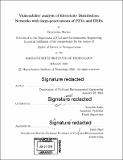Vulnerability analysis of electricity distribution networks with large-penetrations of PEVs and DERs
Author(s)
Shelar, Devendra (Devendra Anil)
DownloadFull printable version (8.053Mb)
Other Contributors
Massachusetts Institute of Technology. Department of Civil and Environmental Engineering.
Advisor
Saurabh Amin.
Terms of use
Metadata
Show full item recordAbstract
This thesis focuses on the vulnerability assessment of radial electricity distribution networks (DNs) under large-scale integration of Distributed Energy Resources (DERs) and Plug-in Electric Vehicles (PEVs). We formulate a two-player Stackelberg security game involving an attacker (external threat agent) and the defender (network operator). First, the attacker targets a subset of the insecure DER or PEV nodes, and strategically manipulates their set-points by attacking the DER/PEV controller logic at the nodes. Next, the defender responds to the resulting supply-demand mismatch by triggering network control operations, which includes direct load control and control of available non-compromised DERs/PEVs. The attacker's (resp. defender's) objective is to maximize (resp. minimize) the weighted sum of the cost of active and reactive power supply, costs of DER/PEV and load control, and the cost due to loss of voltage regulation. This composite cost captures the key trade-offs that the network operator faces in balancing power supply and quality during a broad range of contingency conditions. The choice of this cost in the security game reflects the attacker's overall goal of comprising the DER/PEV nodes to maximize the minimum composite cost for the network operator. Solving the sequential game with nonlinear power flow constraints is a computationally hard problem. To address this challenge, we introduce two auxiliary sequential game problems each with linear power flow constraints. We prove that the values of these relaxed problems upper and lower bound the value of the original game. Next, we introduce a greedy algorithm that can be utilized to efficiently compute an optimal attack strategy for both auxiliary games. Our main result is that, under a set of assumptions, the set of optimal attacker strategies is identical for these games, and hence we obtain a tractable solution to compute an optimal attack for the original game. Furthermore, the optimal attack strategy exhibits an interesting structural property: the downstream nodes are more critical for limiting costs of reactive power supply and maintaining voltage regulation. This insight is useful for vulnerability assessment of DNs under DER/PEV node compromises. Finally, we also exploit the structure of optimal attack to design a distributed control strategy for defender response.
Description
Thesis: S.M. in Transportation, Massachusetts Institute of Technology, Department of Civil and Environmental Engineering, 2016. Cataloged from PDF version of thesis. Includes bibliographical references (pages 95-98).
Date issued
2016Department
Massachusetts Institute of Technology. Department of Civil and Environmental EngineeringPublisher
Massachusetts Institute of Technology
Keywords
Civil and Environmental Engineering.